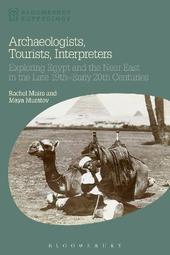
|
Archaeologists, Tourists, Interpreters: Exploring Egypt and the Near East in the Late 19th-Early 20th Centuries
Paperback / softback
Main Details
| Title |
Archaeologists, Tourists, Interpreters: Exploring Egypt and the Near East in the Late 19th-Early 20th Centuries
|
| Authors and Contributors |
By (author) Dr Rachel Mairs
|
|
By (author) Maya Muratov
|
|
Series edited by Nicholas Reeves
|
| Series | Bloomsbury Egyptology |
|---|
| Physical Properties |
| Format:Paperback / softback | | Pages:160 | | Dimensions(mm): Height 234,Width 156 |
|
| Category/Genre | Egyptian archaeology and Egyptology |
|---|
| ISBN/Barcode |
9781472588807
|
| Classifications | Dewey:932 |
|---|
| Audience | | Professional & Vocational | |
|---|
| Illustrations |
20 bw illus
|
|
Publishing Details |
| Publisher |
Bloomsbury Publishing PLC
|
| Imprint |
Bloomsbury Academic
|
| Publication Date |
24 September 2015 |
| Publication Country |
United Kingdom
|
Description
In the late 19th and early 20th centuries, growing numbers of tourists and scholars from Europe and America, fascinated by new discoveries, visited the Near East and Egypt - attracted by the riches and mysteries of the Land of the Bible. Almost all such visitors, no matter how esoteric or academic their pursuits, had to deal with the local authorities and the native workforce for their archaeological excavations. The vast majority of these visitors had to rely on interpreters, dragomans, translators and local guides. This study, based on published and unpublished travel memoirs, guidebooks, personal papers and archaeological reports of the British and American archaeologists, deals with the socio-political status and multi-faceted role of interpreters at the time. Those bi- or multi-lingual individuals frequently took on (or were forced to take on) much more than just interpreting. They often played the role of go-betweens, servants, bodyguards, pimps, diplomats, spies, messengers, managers and overseers, and had to mediate, scheme and often improvise, whether in an official or unofficial capacity. For the most part denied due credit and recognition, these interpreters are finally here given a new voice. An engrossing story emerges of how through their many and varied actions and roles, they had a crucial part to play in the introduction to Britain and America of these mysterious past cultures and civilizations.
Author Biography
Rachel Mairs is Lecturer in Classics at the University of Reading, UK. Maya Muratov is Assistant Professor of Art History at Adelphi University, USA.
ReviewsThis book is a fascinating read from beginning to end. It comes at a time when a post-colonial approach has finally begun to be applied to early archaeological work and not only to non-professional travellers. This new interest, however, has never taken the linguistic issue into account, and thus this book comes to complement the work of scholars engaging with early archaeological colonialism. -- Arietta Papaconstantinou, Associate Professor, University of Reading, UK This interesting and accessible book presents both new and little-known information on the social history of dragomans and interpreters in Egypt and Mesopotamia in the late 19th to early 20th centuries and casts light on and the Anglo-American aversion to learning Arabic and Turkish that made them necessary. Mairs and Muratov excavate new archival sources: a diary and curated testimonial book to discover the voice and agency of two individuals who shaped westerners' experience of the Holy Lands, thereby rescuing them from the anonymity of a client-based perspective. -- Susan Heuck Allen, Visiting Scholar, Department of Classics, Brown University, USA In this well-written and good-humoured book, Mairs and Muratov examine the relationship between dragoman and client, and investigate the ways in which dragomen both reinforced and confronted Western perceptions of the East in the late 19th and early 20th centuries. ... While the book presents a fresh and inclusive social history of formative archaeological work and, especially, early tourism in Egypt and the Near East, its greatest strength ultimately lies in the detailed biographies of its two key protagonists. * Bryn Mawr Classical Review *
|